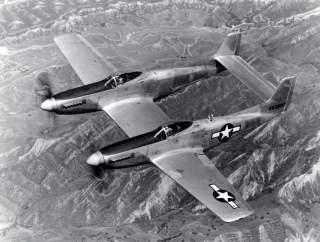Meet the F-82—America's Forgotten Long-Range Fighter
Why have just one P-51 Mustang when you can combine two together?
Despite its superb service in the Korean War, time and technology would catch up to the F-82, and it was quickly phased out in favor of jet aircraft such as the F-86 Sabre.
To many fans of World War II aviation, there is nothing greater than the North American P-51 Mustang, the silvery, iconic warbird that dominated the air in every theatre it flew in.
But what could be better than a P-51 Mustang? Well, at least according to one North American designer, the only thing better would be two P-51 Mustangs fused together.
While strange-looking, the F-82 Twin Mustang was quite the aircraft, and a fantastic all-weather day/night fighter for its time.
The Twin ‘Stangs were a case of something needed to fill a specific need at a specific time. First flying in 1945, the aircraft were soon deemed unneeded after the U.S. P-51s encountered German jet aircraft. Slated to disappear into obscurity, the F-82 was given a second chance in 1947, when a reverse-engineered Boeing B-29 was seen flying with red stars during the Soviet Aviation Day parade.
With no aircraft currently up to the task of intercepting B-29s on short notice, the F-82s (which at the time, were known as P-82s) stepped up to the plate- at least until further technological advances.
Tasked as an interceptor and long-range bomber escort, the F-82E had a range of over 1,400 miles, making a trip from London to Moscow possible with a 30-minute loiter time to spare. At the time, it was the only American fighter capable of doing so, and as such, was invaluable. One F-82, Betty Jo, made history in 1947 after it flew 5,051 miles from Hawaii to New York without refueling.
The Twin Mustangs had a crew of two, though the right side crew member on later models had no controls, and served as a radar operator.
When the Korean War came, the Twin Mustang was given a chance at combat, and quickly made history yet again, taking the first three U.S. air-to-air kills in the conflict.
On June 27th 1950, mere days after photo-reconnaissance F-82s had documented the beginning of the Korean War.
The U.S. Air Force was tasked with evacuating American civilians from South Korea.
Fearing that the North Koreans would shoot at American transports loaded with civilians, a request for fighter cover was made, and several Japan-based F-82s from the 399th Fighter All Weather Squadron were available to answer the call.
Taking to the skies, the Twin Mustangs arrived at Kimpo Air Base in South Korea and orbited in a stacked formation as the transports took off.
Just before noon, a mixed group of Soviet-built North Korean fighters appeared, determined to destroy the transports. The F-82s, however, had other plans and began defending the helpless cargo planes.
During the dogfight, Lt. William G. “Skeeter” Hudson initiated a high-G turn and began peppering a Yak-11 with six .50 caliber machine guns, downing the enemy plane.
The North Korean pilot bailed out and attempted to fight South Korean soldiers on the ground.
Not long after the first enemy plane was downed, Lt. Charles Moran downed a La-7 over the airfield, while Maj. James Little finished off a second one.
Realizing the fight was lost, the remaining two North Korean aircraft fled. The first three aerial kills by U.S. pilots over Korea had been earned, and thus opened a new chapter in a deadly conflict.
Despite its superb service in the Korean War, time and technology would catch up to the F-82, and it was quickly phased out in favor of jet aircraft such as the F-86 Sabre.
Three years after getting its first kill, the F-82 was retired. Much like the “forgotten war” in Korea, the F-82 tends to be overlooked- at least, until someone sees a Twin Mustang in the wild and says, “What on earth is that?”
This article by Andy Wolf originally appeared at War is Boring in 2019.
Image: Wikimedia

